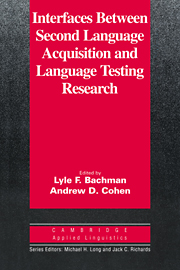Book contents
- Frontmatter
- Contents
- List of contributors
- Series editors' preface
- Preface
- Chapter 1 Language testing – SLA interfaces: An update
- Chapter 2 Construct definition and validity inquiry in SLA research
- Chapter 3 Research on interlanguage variation: Implications for language testing
- Chapter 4 Strategies and processes in test taking and SLA
- Chapter 5 Describing language development? Rating scales and SLA
- Chapter 6 Testing methods in context-based second language research
- Chapter 7 How can language testing and SLA benefit from each other? The case of discourse
- Appendix: Language testing – SLA research interfaces
- Index
Chapter 2 - Construct definition and validity inquiry in SLA research
Published online by Cambridge University Press: 05 October 2012
- Frontmatter
- Contents
- List of contributors
- Series editors' preface
- Preface
- Chapter 1 Language testing – SLA interfaces: An update
- Chapter 2 Construct definition and validity inquiry in SLA research
- Chapter 3 Research on interlanguage variation: Implications for language testing
- Chapter 4 Strategies and processes in test taking and SLA
- Chapter 5 Describing language development? Rating scales and SLA
- Chapter 6 Testing methods in context-based second language research
- Chapter 7 How can language testing and SLA benefit from each other? The case of discourse
- Appendix: Language testing – SLA research interfaces
- Index
Summary
In second language acquisition (SLA) research, some form of measurement is frequently used to produce empirical evidence for hypotheses about the nature and development of communicative competence. For example, SLA researchers test learners to investigate such aspects of interlanguage vocabulary as the acquisition of semantic (Kellerman 1978) and syntactic (Ard & Gass 1987) features of words, the structure of the L2 lexicon (Meara 1984; Singleton & Little 1991), lexicon size (Nation 1993), strategies associated with vocabulary use (Blum-Kulka & Levinson 1983), and automaticity of lexical access (Chitiri, Sun, Willows, and Taylor 1992). Tests are used for investigating vocabulary, as well as for SLA research in general, to elicit learners' performance in a defined context. In other words, taking the complement to Douglas's (Chapter 6, this volume) view of language tests as SLA elicitation devices, I consider SLA elicitation devices from the perspective of two principles that underlie language testing: construct definition and validation.
These principles are important in SLA research because learners' performance on elicitation devices – like performance on language tests – is used to make inferences extending beyond the observed performance. For example, inferences are often made concerning the learner's underlying competence, which is a construct. Justification of the inferences made on the basis of performance is validation. On SLA elicitation devices, researchers would seldom rely on a single observation of performance to make inferences. Instead, performances are typically summarized across observations to produce scores or other descriptions of performance consistency.
- Type
- Chapter
- Information
- Publisher: Cambridge University PressPrint publication year: 1999
- 22
- Cited by

